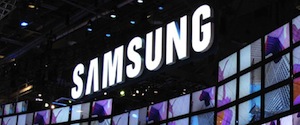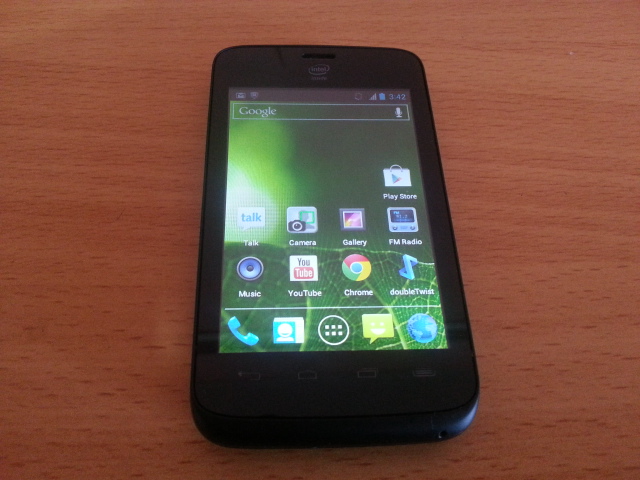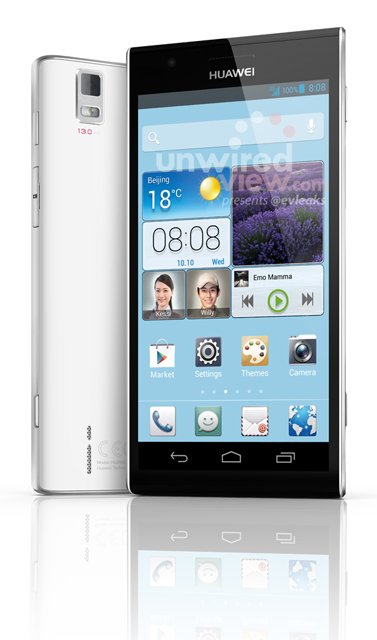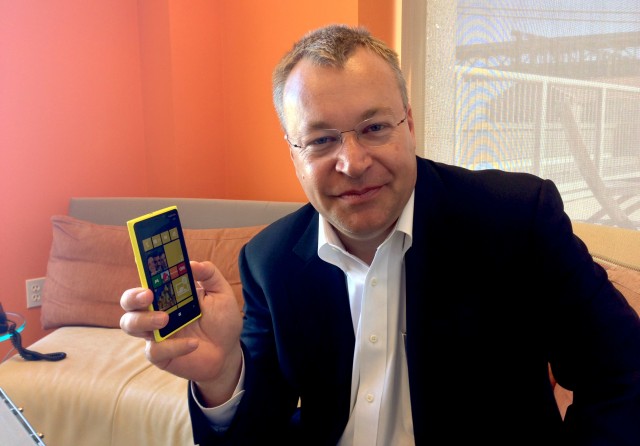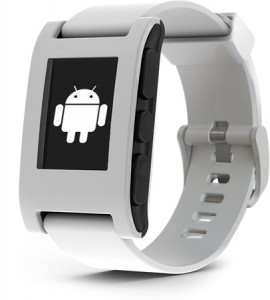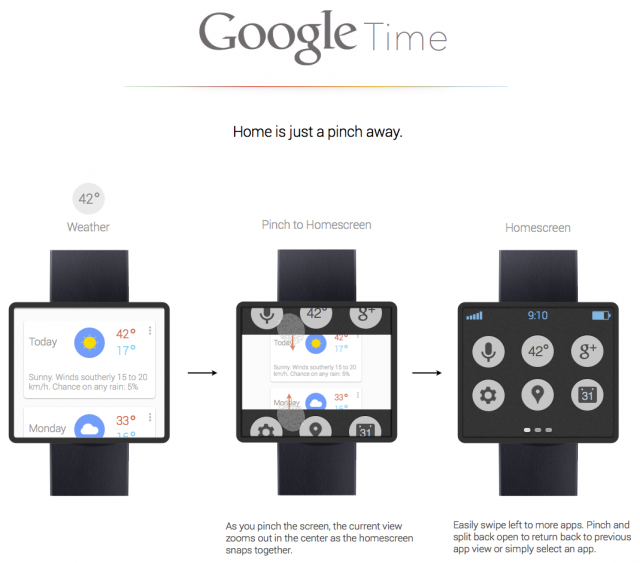Android Authority |
- Lava outs $170 Xolo X500 with battery-saving Intel Atom Lexington chip
- Huawei, Sony and ZTE among top smartphone vendors in Q4
- Samsung delivers once again – profits and sales up in Q4 2012, new records set all-around
- Can Jolla make it big in China as an Android alternative?
- HTC Desire U unveiled in Taiwan – a 4-inch mid-ranger with an unbeatable price tag
- Software update incoming for T-Mobile’s Galaxy S2, not Jelly Bean
- Exynos 5 Octa official image available, well ahead of Galaxy S4, Galaxy Note 3 launch
- Is Sony making a comeback?
- Google’s Project Glass to use bone conducting technology
- Intel launches a smartphone in Africa called “Yolo”, are Western markets next?
| Lava outs $170 Xolo X500 with battery-saving Intel Atom Lexington chip Posted: 25 Jan 2013 03:01 AM PST
Intel is officially looking to become serious about Android with the high-end Clover Trail+ CPU we've only seen inside the Lenovo K900 so far, but that doesn't mean its entry-level focus is completely off. We've only just met the new Yolo phone targeted for Africa, but there's already a new kid on the block with an Intel Inside insignia. The Lava Xolo X500 should also cater to the need of the budget-careful folk, but it will most likely do so in only one country – India. Following in the footsteps of last year's Xolo X900, the new guy looks more like a cheapo alternative to that than an upgrade. The 4-inch 1,024 x 600 pixels resolution display is downsized to a 3.5-incher with just 480 x 320 res, the 1 GB of RAM is cut in half, the 16 GB of on-board storage is butchered to just 4 gigs, while the 8 MP rear-facing camera turns into an underwhelming snapper with just a 5 MP sensor.
The front-facing cam seems to have disappeared altogether, while the premium design of the X900 is nowhere to be found at the dull-looking and possibly too bulky Xolo X500. We can't say we're too fond of the Android 4.0 ICS on board either, although seeing Jelly Bean work with those specs would have probably been an even bigger nightmare. In a surprising twist, the X500 comes rocking the brand new Intel Atom Lexington Z2420 CPU, supposedly capable of "great gaming performance", but mostly improved battery life. Though the processor only has one core clocked at 1.2 GHz, Intel says it's very close to the 1.6 GHz Z2460 powering the X900 from a performance standpoint. Really bold claims and the first thing to look for when the X500 will come out. The first, but not the only one, because the new handheld also packs a 1,500 mAh battery (slightly larger than the one inside the X900 and probably a lot less power-hungry). And to top it all off, Intel has priced this at just Rs. 8,999 ($167). Ah, man, now we're starting to envy folks in India! Anyways, if you are residing there and want a piece of this, you should look for the X500 in stores starting next week. Related Posts |
| Huawei, Sony and ZTE among top smartphone vendors in Q4 Posted: 25 Jan 2013 02:19 AM PST
In third place is Huawei, which managed to ship nearly 11 million devices from October to December 2012. The company, which has entered the top three for the first time, targeted both the low-end and high-end of the smartphone market. The company is using innovation at the high-end to gain market share. During 2012 the company released the world’s thinnest (6.68 mm) smartphone, the Ascend P1, and 2013 is already looking exciting with devices like the 6.1 inch Ascend Mate already making waves. After Huawei comes Sony and ZTE with both companies shipping over 9 million handsets each in Q4. The signs are that Sony could be making a strong comeback and ZTE managed to ship more smartphones than feature phones for the first time in the quarter. Looking at total handset shipments including feature phones, Samsung is still the company to beat with shipments of 111 million devices in Q4 with Nokia and Apple taking second and third place. Although there are some rabid Android fans who would love to see Apple fail at everything, I think due respect must be accorded to Apple in that it is the third largest mobile phone vendor and yet doesn’t sell any feature phones unlike Samsung, Nokia, ZTE or Huawei. Looking back over 2012, the top five smartphone makers by shipment where Samsung, Apple, Nokia, HTC and RIM. The big two have 39% and 25% of the market share respectively while the other three all come in at around 6% each. Obviously HTC’s failure to make it in the top five for Q4 shows its current weaker position even though it managed a top five spot for the entire year. Are you going to buy a new smartphone in 2013? Which manufacturer will you choose? Related Posts |
| Samsung delivers once again – profits and sales up in Q4 2012, new records set all-around Posted: 25 Jan 2013 01:58 AM PST
With the financial state of most OEMs involved in the Android décor being rather gloomy, you can always count on one company to deliver the goods and rake in the big cheese – Samsung. The Koreans have just officially posted their financial results for Q4 2012, wrapping up what's been a tremendous year for the "Galaxy". As expected, all's ended well for Sammy in 2012, with the estimates from a couple of weeks back matched and even surpassed. Starting off with the most impressive number of all, the company's consolidated operating profit for the quarter has been of 8.84 trillion won, or $8.27 billion. That's up from 8.06 trillion in Q3 2012 and 4.67 (!!!) trillion in Q4 2011. Or, if you prefer, a 9% increase compared with last quarter and a whopping 89% growth year-on-year. As far as actual sales are concerned (or revenue), Samsung has brought in 56.06 trillion won ($52.45 billion) between October and December 2012, up from 52.18 trillion in the previous three months and 47.30 in the final quarter of 2011.
We're certain we're soon going to run out of metaphors and superlative adjectives to describe Samsung's current financial state, so let's move on. To the summed up numbers for 2012. Which, you guessed it, are unbelievable. The overall operating profit has been of 29.05 trillion won (a little over $27 billion), up from 15.64 trillion in 2011. Meanwhile, the total revenue has hit 201.1 trillion won, or $188.14 billion. Needless to say that 2012 has been the greatest year in Samsung's history, in profits and total revenue alike, with both of those numbers ruthlessly crushing the previous records. Now, for the part we're all most interested in – Samsung's mobile division. Which, as usual, has been on the up and rise, with 27.23 trillion won raked in Q4 2012 sales. That's a 4% increase compared with the previous fiscal quarter, when Samsung "only" earned 26.25 trillion won through its mobile branch. Also, it's a staggering 58% growth year-on-year, with 17.18 trillion won earned in mobile in Q4 2011.
Of course, for the overall results to look as good as they did Samsung needed its other departments to perform as well, which they unsurprisingly did. The consumer electronics branch brought in 13.95 trillion won in sales (up from 11.60 in Q3, but down from 14.11 in Q4 2011), while the semiconductor business was stable (9.59 trillion won, slightly up from 9.17 year-on-year). The only minor disappointment was the display panel division, where sales were down from 8.55 trillion won in Q4 2011 and 8.46 in Q3 2012 to 7.75 in the last quarter. Getting back to the mobile business, we should mention that Samsung has pinpointed the Galaxy S3, Galaxy Note 2 and Note 10.1 as the three gadgets with the highest demand at the end of last year. There's also the usual caution going in the first quarter of a new year, when smartphone and tablet demand are "to decrease QoQ due to weak seasonality". But can anyone stop Sammy from growing even at the start of a year, where people are usually less interested in buying new products? Related Posts |
| Can Jolla make it big in China as an Android alternative? Posted: 25 Jan 2013 01:02 AM PST
Jolla is betting on China where there are still huge numbers of potential smartphone buyers. Apple hasn’t made as big as an impact in China as it has in the rest of the world and 90% of smartphones currently run Android. Jolla’s plan is to offer its open-source OS as a true alternative to Android. The Sailfish Alliance was formed last November to unit handset manufacturers, chipset makers and network operators to build the whole ecosystem need to make Sailfish succeed Jolla now has a research and development center in Hon Kong which it is using to pull together its different partners and launch into the Chinese market. According to Digital Strategy Consulting, Jolla won’t be aiming initially at the low-end of the market but rather the $500-$800 segment. This upper echelon could make enough money for the company to break even with sales of just 200,000 handsets. It is this start-up mentality and structure that means that Jolla could succeed where bigger companies have failed. Aiming for the top end of the market is a bold move, but it isn’t clear if it is the right one. The danger is the Jolla could invest and innovate but then due to the open source nature of its OS and the culture in China of just copying and cloning, it could suffer and collapse as others make money from its efforts. Also Sailfish isn’t the only Android alternative around. Samsung is involved in an open source, Linux based mobile operating system called Tizen, while Mozilla is pushing its Firefox OS. Recently the Chinese handset manufacturer ZTE revealed that it is is preparing to launch its Firefox OS powered smartphone in Europe before the end of 2013. Are you tempted by an open-source alternative to Android? Let me know by leaving a comment below. Related Posts |
| HTC Desire U unveiled in Taiwan – a 4-inch mid-ranger with an unbeatable price tag Posted: 25 Jan 2013 12:59 AM PST
Okay, so HTC clearly didn't stick to the "hero" strategy announced about a year ago, and continued to segment the company's phone line-up. In fact, we bet it's now much harder for people to keep up with all new HTC devices than it was in late 2011. The hectic branding can't be of much help either, being impossible to differentiate five One devices and six Desires by the letter or letters attached to the names. Then again, HTC does one thing pretty swell by putting its eggs in so many baskets – it covers all bases and caters to every need. Need proof? Meet the Desire U, the newest HTC phone to come to light in Taiwan. This fellow has a lot (and we do mean a lot) in common with a bunch of other members of the Desire family, but it does have one or two things that make it special and attractive. From a design standpoint, there's very little to individuate the U compared with the Desire X, but especially with the V. Just like the V, this new guy measures 9.3 mm in thickness and is really easy on the eyes, with a discreet "chin" and, we think, a plastic/aluminum build combo that ticks both the reliability and sleekness boxes.
The back is a tad different, with a funky striped pattern surrounding the camera. That's definitely a bold, love or hate design choice, but on our part it doesn't look half bad. Moving on from the design, we'll find the Desire U's hardware a bit underwhelming, but not awfully low-end. There's an unspecified 1 GHz CPU beneath the hood (hopefully the dual-core MSM8225 of the Desire X), coupled with 512 MB of RAM. The 4-inch display boasts a 800 x 480 pixels resolution that's awfully familiar for the entire Desire line (including the 4.3-inch SV), while on the software front we must say we're a bit disappointed to see the dated Android 4.0 ICS. Other known features include 4 GB of on-board storage, microSD support, Wi-Fi 802.11 b/g/n, Bluetooth 4.0, a 5 MP rear-facing camera, Beats Audio enhancements and a 1,650 mAh battery. All of these replicate Desire V's specs, so what's special about the U after all? Well, if our sources are correct, the phone is ready to start selling in Taiwan for the equivalent of $275 unlocked, which is a lot less than what the Desire V or X go for. Now, are there any chances to see the Desire U going for a similar price outside Asia? Probably not, but one can definitely hope. Related Posts |
| Software update incoming for T-Mobile’s Galaxy S2, not Jelly Bean Posted: 25 Jan 2013 12:41 AM PST
After months of waiting and anticipating, the Samsung Galaxy S2 finally received its Android 4.1.2 Jelly Bean update. However, only the international version of the phone seems to have been upgraded, while those in the U.S. will have to wait for more confirmation from respective carriers. If you're on T-Mobile, we have some good news and bad news to share. The carrier is rolling out a new software update to the phone, but it's not the one you expected. The 11MB update, which is being rolled out via OTA and Kies, will bring the baseband on your phone to version T989UVLI4. Here's the rather short changelog:
To keep things positive, think of this minor update as a precursor to the big Jelly Bean one, which hopefully is just right around the corner. So, did you get the update yet? Related Posts |
| Exynos 5 Octa official image available, well ahead of Galaxy S4, Galaxy Note 3 launch Posted: 25 Jan 2013 12:22 AM PST
One of the most important Samsung new products unveiled at CES this year was the new eight-core Exynos 5 Octa processor that is supposed to deliver improved performance while also being more battery-friendly than its predecessors. The new chip is expected to be part of Samsung's 2013 high-end family of Galaxy-branded smartphone and tablets, although its not clear which devices will get it at this time. Rumors suggests that the Galaxy S4 will pack an Exynos 5 Octa processor and unnamed Samsung execs have apparently confirmed that the Galaxy Note 3 will feature the new system-on-chip. Considering that Samsung is also set to launch a variety of Android tablets this year, we wouldn't be surprised to see the Exynos 5 Octa inside of them, although there aren’t any specific details about Exynos 5 Octa availability at this point. Meanwhile, we get to check out the official image of the new processor courtesy of SamsungExynos’s Twitter account, which is the only way for most of us to see how this new CPU looks like – unless of course you’ll be prying open your future high-end Samsung mobile product to look for this specific component. Are you buying Exynos 5 Octa-equipped devices this year? Related Posts |
| Posted: 24 Jan 2013 11:51 PM PST
If you're reading this, it's more likely for you to be on a Sony laptop computer than a Sony mobile device. Sony may have the market cornered on premium cameras and game consoles, but it has never really been all-in with mobile. Is all that changing? Is Sony getting ready to take everyone else on? We'll look at where Sony has been, and get a better understanding of where it’s going. If things keep going as they appear to be lately, we'll be considering Sony for our next (and maybe all future) mobile products. EricssonIn the days of ringtones and that silly little snake game being the only option on your phone, Ericsson was as big a player in the mobile industry as anyone. It was a two-horse race with Nokia, and Nokia was producing really inexpensive phones. In an effort to keep up, Ericsson sourced its parts from the same suppliers as Nokia, most notably Phillips. Phillips had a chip manufacturing facility in New Mexico that was dedicated to the tandem of Nokia and Ericsson, so things seemed to be on track. A fire around the turn of the century would threaten the sterility of the factory, thus shutting down production. Phillips assured its two major customers that production would only cease for a week, an aggressive timeline for such an incident. Nokia thought better of that promise and began sourcing chips from otherss. Ericsson did not, and that week turned into months. Faced with supply shortages and upcoming models being held up, Ericsson was left to consider outsourcing or worse, shutting it all down. Ericsson was, and is, a telecommunications business with a stake in networks. It considered mobile to be a huge part of its success with network, so closing down the mobile operations was just not in the cards.
A new hopeAs things looked grim for Ericsson's mobile division, a partnership was considered. Sony was a small player in the mobile market around the year 2000, with 1% of the market share. Both had something to bring to the table: Ericsson had an established market share and brand notoriety, while Sony had a supply chain and forward-thinking designers. The partnership would be finalized in August of 2001, and a long, strange journey would start. At the begining of the partnership, Nokia was really taking off, releasing the iconic 8310 device. Nokia followed that up with the (for the time) revolutionary 5510. Those two phones were cheap, and available anywhere, giving Sony Ericsson fits for getting back into the market. While many believed Sony Ericsson phones were superior, they simply didn't have the same "it" factor Nokia devices had. Picture thisSony was always a leader in digital photography, and as cameras were getting smaller, putting a decent camera in the phone was getting more and more realistic. In 2005, Sony Ericsson released the K750i, which has a 2-megapixel camera on board. Way ahead of its time, the phone simply didn't catch on as well as the company had hoped. The W800i was the first "Walkman" phone, capable of playing music from a Sony Memory Stick, but also failed to resonate with customers. Sony had a lot of very forward-thinking products that failed to catch on widely. The external memory idea was wonderful, and having a good camera on-board was a delight. The inclusion of a color screen that could more accurately portray pictures was a dream. The designs were very sleek and modern, and the build quality was excellent. So, what went wrong? To start, the phones were smaller than what we were used to. Sony Ericsson has always packed more into less, and the market just didn't understand that. Changeable faceplates were the craze, not great cameras. Sony Ericsson offerings were also fairly limited in style, as each phone was a candybar style phone with the same configuration. The use of a Memory Stick was great, but not the industry standard for external memory. It was just a little too much "Sony" and not enough "mobile". A little bit too proprietary and standardized for our taste at the time. Finding its footingAs Sony Ericsson waned here in the States, its profile grew overseas. Europe seemed to love everything about its mobile products, and it showed in the sales. While never a true market leader, Sony Ericsson had a great presence in Europe and Asia. Things seemed to be going well, and then the earth shifted on its axis. The release of the iPhone would shake up the mobile world, and Sony Ericsson was not immune. Everyone was clamoring to get better acquainted with the snappy new device, and its ecosystem. An iPod you could make calls with seemed ideal for many, and most of us already utilized iTunes as a primary source for music. Between those two massive achievements, and the advent of games and apps, everyone was in trouble. In the span of 3 years, Sony Ericsson's handset sales would dip from 30 million in Q4 2007 to 8 million in Q1 2011. Sony Ericsson would, over the next few years, take drastic steps to retain its slight market share. Closing down manufacturing plants across the world, cutting the workforce, and eliminating all-important R&D facilities would be necessary to get back on solid ground. The mobile market, in fact all tech markets, were running away from Sony Ericsson's proven strategy.
It all falls downAround the time Sony Ericsson was experiencing a worldwide meltdown, the world economy was following suit. As President Obama took office, and control of a gigantic economic mess, the irresponsible investments of the U.S. market were having ripple effects all over the world. The economy would rebound, but those things take time. Sony Ericsson was in deeper water than imagined. A premium device manufacturer has no space in a financially strapped world. Sales had slowed dramatically, and reviews were changing to suit an economic mindset. Where we once praised Sony Ericsson for producing top-notch stuff, we now damned the company for its pricing policy. There were other products with similar specs, and at half the price. Sony Ericsson, it seemed, was doomed. It would take a little self evaluation before it could get on the right path.
Silver liningSony has proven resilient, and the economic downturn had been a wake-up call. Sony will never compromise quality, but price is another point altogether. While the market may have drifted from Sony's method of "top quality, top dollar", it has not been lost on Sony. Having assumed Ericsson's stake in the company back in 2011 would clear up any confusion about who or what Sony Ericsson was, and Sony Mobile could move forward in a pointed direction. Its first offering as Sony Mobile, the Xperia S, was well received and packed some serious punch. A 12MP camera and dedicated camera button would thrill owners. In true Sony fashion, it was a bit ahead of its time, only being offered in an unlocked version. At $549, the phone was typical of unlocked device pricing, but that was not appropriate for the market at the time. No carrier subsidy meant few would pick up this great device domestically. Once again, Sony made a great showing abroad with little attention stateside. Recognizing the industry scope, and all its trends, Sony Mobile dedicated itself to less fragmentation. The decision to produce only smartphones – and later tablets too – is both a new direction and the same ol' story from Sony. We'll get great hardware as always, but deciding to focus energy in on one product line is not Sony's bailiwick. It's a wise move for a company that has a propensity to do too much and pay the price, and the dedication to one craft can only be beneficial to consumers.
Boomerang effectIt can be said that Sony "is what it is", and always has been. Sony puts out awesome hardware, as it’s the company’s strength, but has often been the only one doing so. With the mobile industry coming around to do the same, it's like throwing fastballs right into Sony's wheelhouse. Rather than wander aimlessly in the wild, Sony now has a rare opportunity. If the game is great hardware, then Sony's initials are at the top of the leaderboard. As we inch toward an Android universe where great hardware is necessary to keep up with our fabulous OS, the rest of the industry better look out. Sony has the design and hardware to make heads turn, and its innovations are still ahead of their time. No device is perfect, but the Xperia Z and ZL are potentially disruptive to the Samsung status quo. From proprietary to priorityAndroid is nothing without its developers, and Sony understands that. So, when AOSP decides to focus on your device for "experimental" purposes, it's wise to respond graciously. Sony did just that, and the project was labelled a "success" by AOSP leader Jean-Baptiste Queru. Will this lead to a Sony Nexus device in the future? Who knows. Having a good relationship with the project and and maker of your device's OS is never a bad thing, though. In addition to this, it seems Sony is keen to working closely with XDA developers, going so far as to give elite developers an Xperia T to play with. A bit of humble pie with a side of brilliance is a great dish for Sony, and it seems it ate it up. Sony isn’t Android's favorite son, but it knows real support starts and ends with developers. It also gives Sony valuable feedback for future devices, allowing for a more seamless interaction.
Time, the great equalizerIt seems as though Sony is well on its way to becoming a very sound mobile device maker. It also is in a privileged position to really shape the mobile hardware industry, as its innovations are still out in front of the pack. Having always built very solid devices, Sony Mobile is ahead of the curve with design and functionality. If there is room to stand out in a crowd of devices that all look the same, Sony will find it. A beautiful device does not bring success every time, though. While unlocked phones may be the global standard, the U.S. market still operates with carrier subsidy for the time being. If Sony can make the device available to the carriers, it will start to get the attention of consumers. Having an Xperia in-hand will cause many to resist putting it down. If a final word of caution is to be levied, it's this: don't screw with Android. Samsung and HTC have their own spins on Android with TouchWiz and Sense, respectively, but I'd caution Sony against following suit. Adopting the developer community as a favored partner was a great step, so it should build on that. Can you imagine a Cyanogen or Paranoid Android build on an Xperia… out of the box?! Now THAT would be a leap forward. ConclusionThe world finally caught up to Sony build quality, which makes us wonder if Sony was right all along. Sure, the pricing structure has changed, but was a premium device the answer we always needed? Perhaps we should have been paying attention to Sony the entire time, rather than toy with the likes of a nearly defunct Nokia or struggling HTC. Sony has the makings of the next Samsung, and we'd be wise to not dismiss them again. Related Posts |
| Google’s Project Glass to use bone conducting technology Posted: 24 Jan 2013 11:14 PM PST
Google's Project Glass is an interesting product due to its mystery but also because of how "unsecretive" they really were when demonstrating it to the public. We have all seen it be officially demoed, we all know it exists, but none of us are anywhere close to being able to own a pair. This is why new developments on this product are so huge. And now we have a better idea of how sound will be delivered to the user fromthe glasses Google is reportedly fitting the glasses with bone conduction technology in order to avoid having a separate ear piece. Bone conduction is essentially making the glasses vibrate, transferring the sound to your bones and ultimately, your inner ear. For those of you familiar with bone conduction headphones and handsets, Google's method is going to behave a little differently. In devices using bone conduction technology that we've seen previously, there is a vibration transducer that vibrates directly on your bones, injecting the sound. However, Google is reportedly using the actual glasses as the vibration transducer. This is possible because the glasses will be in contact with your bones at all times anyway. As it stands, there is possibility of potential customization when it comes to where the user actually wants the sound delivered. Google has mapped out four possible locations for sound delivery: near the eyebrow, behind the ear, above the nose, or near the temple. We aren't exactly sure if the location of sound delivery will change according to body type, personal preference, or a simple choice by Google. These details, available in a patent Google filed back in October 2011, were just made public and really shows Google's commitment to this technology. Related Posts |
| Intel launches a smartphone in Africa called “Yolo”, are Western markets next? Posted: 24 Jan 2013 07:12 PM PST
Intel, who has been trying to become a serious player in the mobile industry for what feels like forever, has just announced that they’re launching a smartphone in Africa called the Yolo. The device will be sold by Safaricom for roughly $125, so don’t expect this thing to be bleeding edge. It has a 3.5 inch 480 x 320 pixel display, it’s powered by a single core Atom processor clocked at 1.2 GHz, and it even has HSPA+ support. What interests us is who actually made the device? By that we mean who did the manufacturing? Did Intel call up a Chinese OEM and ask them to make a bunch of Yolos for Africa? Did Intel themselves make the Yolo and customize it for Safaricom? These are important questions since the answers might give us a clue as to how Intel plans to make themselves relevant in Western markets. Maybe the only way for Intel smartphones to become popular in places like the United States and Europe is for Intel to actually make the phones themselves instead of just focusing on the chips that go inside the phones. Think about the ramifications of that for a second. On the flip side, there are two notable companies who have shown interest in working with Intel: Motorola and Lenovo. Motorola is now owned by Google, so it’s not too difficult to imagine that Google would want to differentiate themselves from Samsung and Apple by launching Intel powered smartphones. And then there’s Lenovo, who may not be big outside of China, but in China they’re a massive player. When Lenovo does decide to start playing in the West, maybe they’ll ask for help from Intel? It’s early days for Intel, which is good, because smartphone sales are still a fraction of phone sales overall, so there’s room left to innovate. Qualcomm and NVIDIA should definitely be scared too, because when Intel wants something, they usually get it. Related Posts |
| You are subscribed to email updates from Android Authority To stop receiving these emails, you may unsubscribe now. | Email delivery powered by Google |
| Google Inc., 20 West Kinzie, Chicago IL USA 60610 | |



 The last three months of 2012 saw some radical shifts in the performance of smartphone makers with Huawei, Sony and ZTE all gaining and HTC falling. According to new data released by IDC, Samsung and Apple remained the two biggest smartphone makers with Samsung shipping some 63 million units and Apple shipping nearly 48 million devices. However the surprises come in the next three spots in the top five.
The last three months of 2012 saw some radical shifts in the performance of smartphone makers with Huawei, Sony and ZTE all gaining and HTC falling. According to new data released by IDC, Samsung and Apple remained the two biggest smartphone makers with Samsung shipping some 63 million units and Apple shipping nearly 48 million devices. However the surprises come in the next three spots in the top five.

















